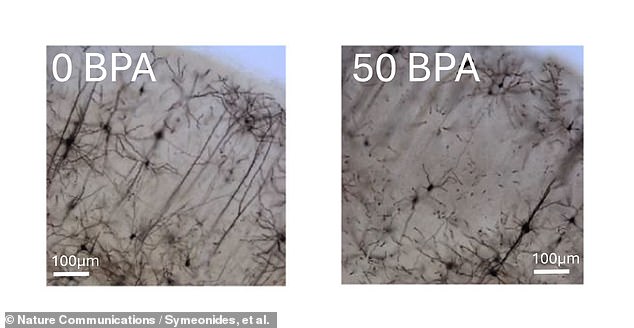Scientists say they may have discovered a shocking cause of autism
A common plastic additive found in everything from pacifiers to canned food and even paper receipts has been linked to an increased risk of autism in boys.
New research, which followed the development of more than 600 babies, found that higher levels of the chemical bisphenol A (BPA) in a pregnant mother’s urine tripled the chance that a baby boy would develop symptoms of autism before the age of two.
Worse yet, these same boys were six times more likely to be diagnosed with autism at age 11, compared to boys whose mothers had lower BPA levels during pregnancy.
BPA, a chemical that is designed to harden plastics and prevent metals from rusting, among other things, has also been linked to increased risk of obesity, asthma, diabetes and heart disease, as the substance has come under increasing scrutiny over the past two decades.
New research from Australia, tracking the development of more than 600 babies, found that higher levels of the chemical bisphenol A (BPA) in a pregnant mother’s urine more than tripled the chance of a young boy developing symptoms of autism at age two.

In addition to surveying more than 600 human children, who have been followed since 2010, the study also tested laboratory mice to track the effect of BPA on brain development and autism. Photomicrographs of cortical neurons in laboratory mice (above) show the damaging impact of BPA
It has also been called a “gender-bending” chemical because of its alleged role in causing hormonal and sexual disruptions in humans, fish and other species.
The new research not only demonstrated the clear link, but also provided evidence to unravel the specific chemical reactions that contribute to cases of autism.
“Our work is important because it shows one of the biological mechanisms that may be involved,” said epidemiologist and public health physician Dr. Anne-Louise Ponsonbyshe said in a statement about her team’s investigation.
‘BPA can disrupt the hormone-driven development of the brains of male fetuses in several ways,’ Dr. Ponsonby explains, ‘including by disabling an important enzyme, aromatase. Aromatase regulates neurohormones and is particularly important for the development of the brains of male fetuses.’
Aromatase helps convert a number of male sex hormones in the brain, called neural androgens, into neural estrogens, the new research finds.
These estrogens help all people, regardless of gender, regulate inflammation in the brain, maintain the flexibility of the synapses that promote communication between neurons throughout the nervous system, and help regulate cholesterol.
The brain is the organ in the human body that contains the most cholesterol. It uses about 20 percent of the body’s total supply of fat molecules to perform its vital functions.
“We found that BPA suppresses the aromatase enzyme and is associated with anatomical, neurological, and behavioral changes,” study co-author and biochemist reported Dr. Wah Chin Boon.
“This seems to be one piece of the autism puzzle,” Dr. Ponsonby said.
The team’s research, published Wednesday in the journal Nature communicationused two separate research approaches to arrive at these findings.

‘BPA may disrupt the hormone-driven development of the male fetal brain in several ways,’ explains public health physician Dr Anne-Louise Ponsonby, ‘by suppressing an important enzyme, aromatase, which regulates neurohormones and is particularly important for male fetal brain development.’

The team experimented with adding a type of fatty acid called 10-hydroxy-2-decenoic (10HDA) which they found could reduce the negative impact of BPA on the aromatase system of the developing brain. Above 10HDA, the impact of BPA on mouse neurons is reduced
First, it delved into data collected since 2010 by two Australian universities that have tracked a range of health statistics from more than 1,000 participating children and their parents, known as the Barwon Infant Study (BIS) Birth Cohort.
Within the BIS data, 676 infants were sufficiently tested for early-onset autism symptoms for the team to draw statistical conclusions.
These ratings, based on the Autism Spectrum Problems scale of the Child Behavior Checklist (CBCL ASP), were weighted to rule out genetic predisposition or other variables and thus isolate the role BPA plays during pregnancy.
This weighted analysis found that young boys with ‘low aromatase activity’ were 3.56 times more likely to show signs of autism at age two.
This remained true as the boys grew older, they noted: “CBCL ASP at age two strongly predicted diagnosed autism at age 18 and moderately at age 9.”
Their research found that the association with an autism diagnosis applied to 92 percent of four-year-olds and 70 percent of nine-year-olds.
The team also conducted tests in laboratory mice to understand how BPA undermines this important aromatase activity and what treatments might combat this.
During these tests, the team experimented with adding a type of fatty acid called 10-hydroxy-2-decenoic (10HDA). They found that this could help mitigate the negative impact of BPA on the aromatase system of the developing brain.
“When administered to animals prenatally exposed to BPA,” Dr. Boon explains, “10-hydroxy-2-decenoic acid shows early evidence that it can activate opposing biological processes.”
10HDA, a major fatty lipid ingredient found naturally in honeybee royal jelly, competes with BPA in the brain and prevents the disruptive substance from binding to estrogen receptors.
Their mouse study found that adding 10HDA to BPA-exposed male mice improved their ability to interact with other mice.
“More research is needed to see if this potential treatment can be applied to humans,” said Dr. Boon.
